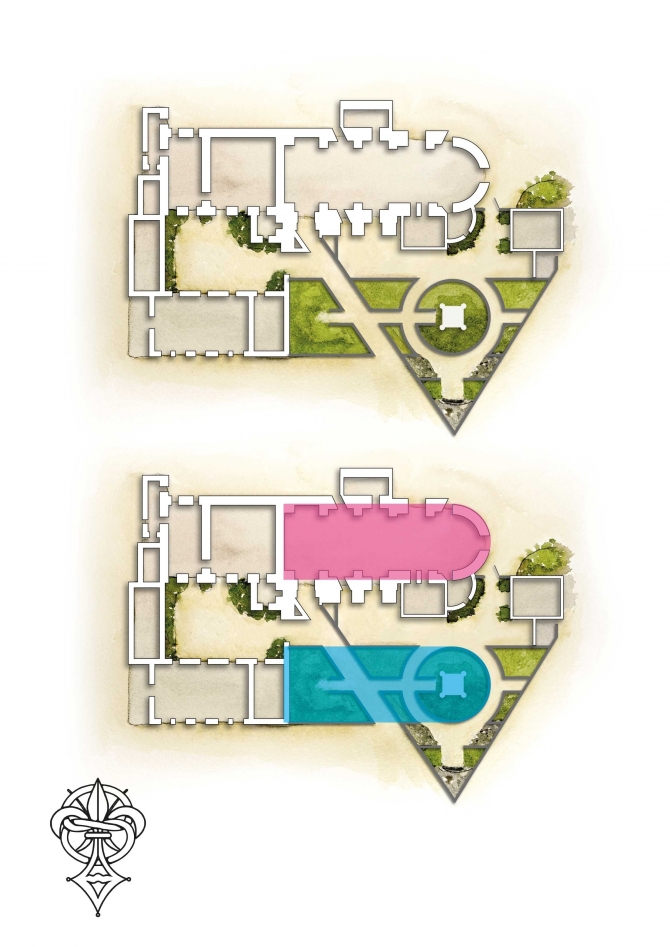- Home
- Expulsions and impostures
- PHOTO GALLERY
- Commanderies and Chapters
- Myth or reality?
- Templar Knights
- The Grand Master
- Rituals
- Regalia
- The Sword in the Rock
- A primitive christianity
- The gnostic key
- The alchemical secret
- Jesus and the Grail
- Who we are
- Introduction to the Website
- A noble Order of Chivalry
- Story of the Priory of Sion
- Genealogy of Jesus and Mary
- The Merovingians
- The heirs of the Royal Blood
- Pierre Plantard de Saint-Clair
- Eggregore
- Priory of Sion - Illuminati
- Rhedae - Rennes Le Château
- Church of Rennes le Château
- The Rosicrucians
- Meditation
- "Magical" thinking
- Priory of Sion and Freemasonry
- Egyptian Freemasonry
- Sang Real
- Earthly Life
- The biological machine
- Role of Man
- Spirituality
- Spiritual awareness
- Destiny
- Biological "Reincarnation"
- "Cercle Sigebert IV"
- Admissions and Initiations
- Initiatic Degrees of the Order
- Video
- Prayer to the Father Creator
- Universal Brotherhood
- International Treaties
- Gazette de Rennes-le-Château
- Statute
- Internal Regulation
- Organization Chart
- Tribe 13
- Journal
- Links
- Recommended readings
Priory of Sion
Ordre de la Rose-Croix Véritas O.D.L.R.C.V.
Church of Rennes le Château
SYMBOLOGY OF THE RENNES-LE-CHÂTEAU CHURCH (VIDEO)
THE CHURCH OF SAINT MARY MAGDALENE IN RENNES-LE-CHÂTEAU
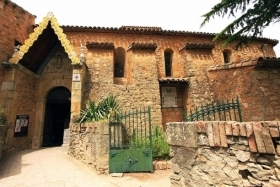
There is a church in France, which directly testifies the tradition that sees St. Mary Magdalene as the one who had given a descent to Jesus and was directly linked to the mysteries of the Holy Grail; this church, through symbols and allegories, indicates clearly and incontrovertibly, once examined, the will of those who have restructured and kept it, to relate the "Grail" with Mary Magdalene, at the same time, will prove the place of discovery of important historical documents that would prove the connection between the Merovingian Dynasty and the blood line of Jesus; of this knowledge, only the oral tradition and some elements of investigation currently come to us, and we are therefore still on the trail of the original documents, still lost today.
But let's see how all this emerges from the analysis on the church of Saint Mary Magdalene in Rennes le Château.
The church of Saint Mary Magdalene in Rennes le Château was consecrated in 1059, initially as the chapel of the Counts of the Razès. It was later renovated in the modern era by Bérenger Saunière from 1886, which on the occasion of the renovation has included all the symbolic, allegorical and decorative elements that we can still admire today, which serve as a vehicle for very precise secrets and hidden knowledge.
The church dedicated to Saint Mary Magdalene, which rises from the remains of a Celtic temple dedicated to Isis, enjoys stylistically and architecturally also the Visigothic influence as the Carolingian's, and this makes it an architectural jewel of particular rarity and preciousity, since what has now become, is the result of all these influences that have been added over time in a happy harmony.
Only the renovated church building cost the equivalent of tens of millions of euros, entirely paid by a priest of humble origins, named Bérenger Saunière, who had arrived in Rennes le Château without any economic resources except the skinny monthly allowance from a parish priest at the time.
With this research we will try to provide concrete and verifiable elements that can open different coherent paths to explain how all this has been possible.
SYMBOLOGY OF THE RENNES-LE-CHÂTEAU CHURCH
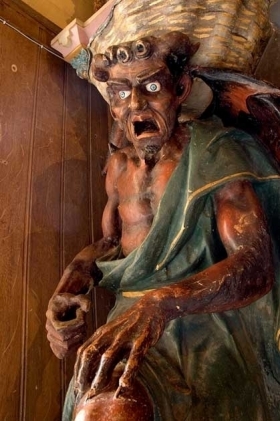
Taking us inside the church, we can first make sure that it is equipped with 9 main statues, plus the representation of St. Luke on the side of the pulpit.
- The Asmodeus Demon carrying the holy water font and the four angels placed above.
- Saint Germain
- Saint Roc
- Saint Anthony the hermit
- Saint Anthony from Padova
- Saint Luc (depicted on the side of the pulpit)
- Saint John the Baptist
- Saint Mary Magdalene
- Saint Mary, mother of Jesus
- Saint Joseph
THE DISPOSITION OF THE STATUES
As can be seen from the overlay scheme, by isolating the initials of the statues around Mary Magdalene, the word "Grail" appears and the "M", initial of Mary, is formed.
It is clear, the absolute evidence of the certain and conscious intention of Saunière, to communicate unequivocally to anyone who was able to solve this allegorical code, that the Grail existed and was directly connected to Saint Mary Magdalene.
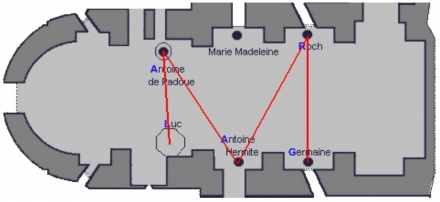
THE OLD ALTAR AND THE PILLAR WERE HIDDEN THE PARCHEMINS
All that is known today on the altar that was present in 1885 (the date on which Saunière had the administration of the church) is that "The main altar was composed of a large slab, fixed on one side in the wall and supported in front by two pillars, one rough, which today is no longer present and the other carved with a cross inlaid with gems and the two greek letters, A and Ω.
It was the initiative of Bérenger Saunière, to replace this old altar with a newer one, to have the famous scrolls discovered.
Saunière finally moved the pillar from inside the church to the garden, where he placed the statue of the Virgin Mary on it and added an engrave:
MISSION 1891
The pillar was positioned inverted, then turned upside down, in order to symbolize the corresponding "double specular", "negative" or "feminine" of the church, which was placed in the garden; that is, the external garden, as we shall see later, was designed to be the exact mirror copy of the church plan and many outdoor furnishings were turned upside down to affirm this realization symbolically.
THE CHEMIN DE CROIX
The Chemin de Croix of the Church of Saint Mary Magdalene that is not read from left to right as in most of the other churches, but in an anti-clockwise direction, then from right to left, has struck, get fervent public attention, particularly because in the last station, the fourteenth, Jesus would be taken to the grave at night, and with full moon, while in the biblical version admitted also by the academic authorities, the burial of Jesus takes place at the afternoon and not at night; in this way, the question inevitably arises about why the burial would take place at night, with the implicit doubt that this was not the burial, but the removal of the body of Christ from the grave.
It is evident that we can not find ourselves faced with an error, but rather with a message from Saunière, who has deliberately tried to transmit a secret, concealing it and exposing it at the same time, in this way.
Given the undoubted competence of the priest regarding religious history, such an error is absolutely unthinkable, on the contrary, it can only open our eyes further on a precise and coherent intention.
Another important detail is that the mountain range on the horizon looks very much like the Bugarach, a mountain, which can be seen very well from Rennes-Le-Château.
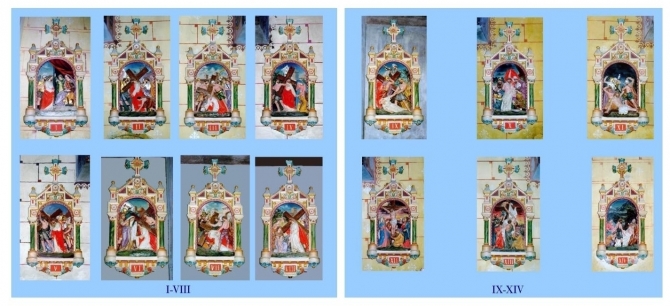
THE 17 OF JANUARY AND THE "BLUE APPLES"
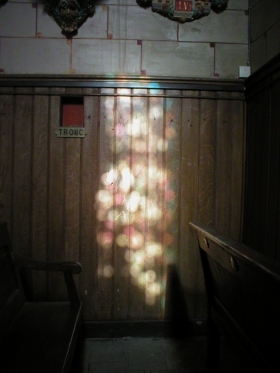
On 17 January every year, near the statue of St. Anthony the Hermit, from 11.00 A.M., a suggestive and ethereal composition, always invisible, during every other day of the year, appears projected on the wall; those are the famous "blue apples" of the church in Rennes le Château.
The phenomenon is the result of a formidable creation by Bérenger Saunière, which exploits a highly elaborate combination of deep geometrical and astronomical knowledge, the result reaches its peak around 13.00 on the 17th of January every year, and from that moment, for a few days more, this phenomenon repeats itself.
The intention of the priest was to celebrate and underline, with the usual allegorical veil, a series of recurrences, which he considered important; among them the date of Marie de Negri of Ables d'Hautpoul's death, the Marquess of Blanchefort-Hautpoul, the last noble whose burial is in the church and besides that, also the date of the death of Saint Anthony the hermit and of Saint Germain from Pibrac, both represented within the church itself, as already mentioned; this particular date has many meanings also for the Priory of Sion, both for the reasons listed above, and for being the day defined as the date of the success of the "Great Work" by the past Grand Master of the Order, Nicolas Flamel, as it was January 17 that he and his wife are said to have obtained the Philosopher's Stone; January 17 is also the date of the death of Bérenger Saunière, so January 17, 1917, death declared by Marie Denarnaud only a few days later (January 22).
THE PILASTER AND THE PARCHEMINS
It was Antoine Bigou, chaplain of the noble family of Blanchefort, having forged them, having had the famous parchments first hand, as well as the documents of the Marquess.
The Marquess of Blanchefort, Marie de Négri d'Ables, wife of François d'Hautpoul, in 1732, was made the depositary of an important, perhaps historical, family secret and received in custody some documents, central in relation to this secret; these documents, together with the his wills, were handed over by François-Pierre d'Hautpoul to a notary in 1644, and it seems that after his death these documents passed from notary to notary until the Marquess of Blanchefort. The husband of the Marquess would have tried several times to recover them or to know their contents, but without success; the Marquise succeeded in excluding her husband from the secret.
It was at this very moment that the Marquess prepared her will, handing these documents to Antoine Bigou.
Marie de Négri d'Ables died on January 17, 1781, and from that moment on, Antoine Bigou maintained her commitment in the utmost scruple, mastery and diligence.
The Abbot Bigou thus forged the stele (on the left) and the tombstone (on the right) for the Marquess de Blanchefort,
together with having produced the famous parchments, containing the precious secrets confided to him by the Marquess on her deathbed.
One of the most significant keys to interpretation can be obtained by observing the tombstone stele, which according to the reproduction received today, showed several errors of writing apparently deliberate, because in the whole, it outlines a sure coherence; errors found through some letters that are evidently smaller, that is: e, E, E, P, and a letter "M" that is isolated from all the others; the date of death instead reports an anomalous "O", which obviously has no correspondence with the Roman numbers, the "R" in "ARLES", instead of the correct "B" of "ABLES", is a further mistake so grave that it appears to be mischievous, because the Marquess was precisely an "Ables" while on the first line the "T" replaces the most appropriate "I". Properly rearranged, the eight extrapolated letters form the two words "MORT" and "EPEE", which stands for "sword of death", "death and sword" or "death by sword", clamorous assonance with the story of the death of San Dagoberto II, who was assassinated just by the sword, during an attack in a wood near Stenay.
The composition of letters "MORTEPEE", used through the Vigenère system, as a decryption key to be applied to the so-caled "Big Parchemin", will give access to a sentence derived from 128 letters, which we will shortly illustrate in this study, which in turn, it will give access to links that connects to precise indications that refer to particular works of art.
The inscription on the stele is composed of 119 characters, and, thus completes with its errors, together with the above-mentioned sentence of 128 characters, derived from the "Big Parchemin", is part of a further perfect code of 247 letters, which can be deciphered writing on two pieces of paper, or on the same sheet, but separately, the two texts, at this point it will be sufficient to delete all the corresponding letters between the two texts and the result, generated by the letters advanced by the larger text, will be exactly the composition "PSPRAECUM", which corresponds to an inscription that we find on the slab.
In addition to this, with no possibility of approximation, we can find the presence of hidden geometric elements of considerable precision on the stele, which can be obtained by connecting the single "wrong" letters to the Cross of Jesus with a line, resulting in an isosceles triangle and a perfect pentacle, which proportions respect the golden ratio without fail, giving us also a mathematical and geometrical test of the author's will and skills.
It should be pointed out that is contemplated the hypothesis that the original stele was devoid of the linguistic anomalies that make up the code under examination and that the one arrived at our analysis was forged by Bérenger Saunière (instead of Bigou) , which would then include the codified elements.
At the same time, on the Marquise tombstone we find a certain combination of Greek letters, which, transposed into Latin, gives us as result a rather decisive, as etonating, combination.
The famous motto that we find in the "Bergers d'Arcadie" by Nicolas Poussin, which we will deal with later.
Returning instead to the scrolls made by Bigou, they were hidden in the church of Rennes le Château with other documents, where they remained until they were found by Bérenger Saunière.
This secret would be at the origin of the "affaire" of Rennes-Le-Château.
The Abbot Bigou then transmitted the secret to another priest, Abbot Cauneille and the latter communicates it to two other priests, Father Émile François Cayron, and the parish priest of Rennes les Bains, Jean Vie, who was the predecessor of Boudet; it is essential to know that Emile François Cayron was the mentor of the young Henri Boudet who became the curate of Rennes les Bains and this passage is fundamental because it highlights the connection between Antoine Bigou and Henri boudet, author of "La Vraie langue celtique et le Cromleck de Rennes-les-Bains ", a literary work famous for being suspected of actually being a code that could lead directly to the true tomb of Jesus in Languedoc.
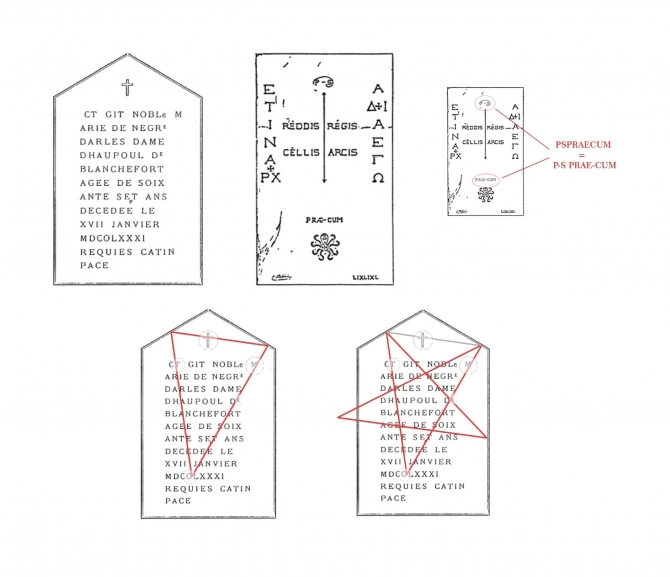
THE "BERGERS D'ARCADIE" BY NICOLAS POUSSIN – "ET IN ARCADIA EGO"
"Et in Arcadia ego" is the inscription that we find in the form of a code on the tombstone of the Marquess de Blanchefort, Marie de Negri D'Ables, and it is also the inscription famous all over the world for being used in some important paintings and sculptures of the seventeenth century, as also by Nicolas Poussin, precisely as a tomb inscription on the painting "Bergers d'Arcadie" (1638-1640), which is in particular the work we will discuss on this occasion.
The phrase "Et in Arcadia Ego", can literally be translated into "Also in Arcadia i am", where Et stands for "etiam" = "also" and implies "sum" = "I am present" or "eram" = "I was".
The inscription itself, lends to different interpretations as well as being able to generate astonishingly pertinent anagrams, among which
ET IN ARCADIA EGO = I TEGO ARCANA DEI
(I protect / hide the secrets of God)
ET IN ARCADIA EGO SUM = TANGO ARCAM DE IESU
(I touch the tomb of God Jesus)
Analyzing the picture, there are therefore extremely precise geographical references, which, due to their unequivocal verifiability, demonstrate an indisputable relevance; the profile of the mountains painted in the background, represent beyond doubt some mountainous summits well known in the Razès and very close to Rennes le Château, that is the Mont Cardou, the Bugarach, the Blanchefort mountain and the hill of Rennes le Château, which it is the same landscape that is found by observing a sepulcher (from a certain perspective) that was located right in that area and of which we are going to expose the story, which was called the "Tombeau des Pontils".
The so-called "Tombeau des Pontils", which it was possible to admire until a few years ago, before being demolished by the owner of the land,
it was a sepulcher identical to the one painted in the aforementioned work by Poussin; this tomb was well known in the Languedoc and later also internationally as "Tombeau des Pontils", taking its name from the area in which it was located, "Les Pontils".
The "Tombeau des Pontils", however, is not prior to the work of Poussin, but rather is erected according to the canons of that parallelepiped structure, which incorporates in the geometric features the tomb's depicted in the painting by Nicolas Poussin; this tomb was builded only in 1930, on the foundations of a pre-existing tomb from 1903; this passage is important, because the tomb resides in a point that is a crossroads of stunningly coherent geographic and geometric coincidences.
This tomb, so macroscopically resembling the sepulcher depicted in the famous painting by Nicolas Poussin, comes to be known by the public through Gérard de Sède, who will write about it in his "La Race Fabuleuse - Extra Terrestres Et Mythologie Mérovingienne".
The "Tombeau des Pontils" is exactly aligned (with a very reasonable gap, considering the time, of 200 meters) under the meridian of Paris, which crosses the North and South Pole, passing precisely to the center of the Paris Observatory, located at 2 ° 20 '13.82 "east of Greenwich.
This particular, in the eyes of many, is considered an explicit "signature", of selective nature towards the recipient, by someone in possession of a certain type of advanced knowledge possible to be hold just in very small groups, especially at the time; the alleged author apparently wanted to reveal "in secret" the importance of that place only to recipients who had the same advanced and exclusive knowledge of the sender.
The seemingly more contradictory mystery lies in the fact that Nicolas Poussin never set foot in the Razès in all his life, but with time, this theory, of Poussin painting the landscape of the Razès, get justified, even with good reasons, coming to knowledge of the fact that a close friend of his, Ambroise Frédeau, a famous local painter, who worked extensively near Toulouse, attended a workshop between Limoux and Alet and especially in that workshop it was very common to portray that area of Razès and for this reason it is possible that Ambroise Frédeau, if necessary, could have helped his friend Poussin, when he wished to portray that background for some reason.
Considering the influence of the priests at the time, therefore also of Henri Boudet, author of "La Vrai Langue Celtique", and of the size of the area and of the population, it is very reasonable to assume that the prelate, still alive at the time, he was easily aware of who the owners of the land was, in this case the Galibert family, and convinced them to erect the "Tombeau des Pontils" in that exact position, which would then be materially realized through the mason Bourrel, of Rennes les Bains; one can not forget the fact that this happened in 1903, exactly the period during which Bérenger Saunière set up the church of Saint Mary Magdalene and its surroundings, with the symbols and allegories we are dealing with.
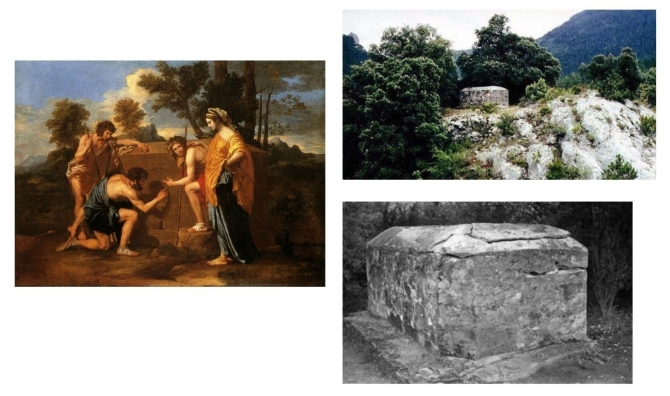
MISTERY OF THE PARCHEMINS
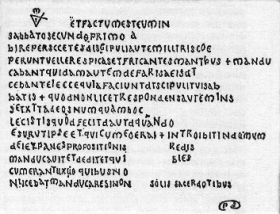
Coal copies of all the documentary finds, including the famous parchments, were made by Bérenger Saunière and later inherited by his perpetual devotee, Marie Denarnaud, his universal heir, who, among other things, tried to get in contact, in 1938 , with the grandfather of Pierre Plantard de Saint-Clair, at the time already deceased, and it was on that occasion that the first contact of Marie Denarnaud took place, with the young Pierre, still eighteen. It was during one of those meetings, in that same year, that Pierre Plantard received from Marie Denarnaud, some copies of those same original carbon copies, and from that moment he felt invested, together with the receipt of that deposit, of a great responsibility.
The copies in question, received by the young Plantard, are those relating to the two parchments forged by Abbot Bigou and to some transcripts of the documents to which the priest had access through the Marquess of Blanchefort-Hautpoul, Marie de Negri D'Ables.
"PIERRE ET PAPIER"
Philippe de Cherisey drew up a document of 44 pages entitled "Pierre et Papier", which provides some partial decoding elements, attributing the paternity of the parchments, which we can say today not be true, but done at the time for reasons that have now stopped to be relevant.
This is the only cause for which today many mistakenly think that these scrolls were really the pure fakes created by the Marquis De Cherisey.
Today we can therefore say that the elements reported on "Pierre et Papier", are far from being the complete key of decoding.
An appraisal by a good cryptologist is enough to prove that the code is exponentially more sophisticated than Philippe de Cherisey has shown, showing that the elements illustrated by the Marquis are just a very limited portion of the coding that was at the base of the parchments.
In any case, among the most significant elements, so far deciphered, is the coded message of the so-called "Little Parchment", which links King Dagobert II, later made Saint, to the Order of Sion.
"A DAGOBERT II ROI ET A SION EST CE TRESOR ET IL EST LA MORT"
Literally translatable into
"To Dagobert II King and to Sion it is this treasure and it is there dead"
Phrase which can be interpreted as
"This treasure belongs to King Dagobert II and to Sion, and it is (the treasure) there, dead"
This interpretation therefore embraces the hypothesis that the treasure in question, connected to the King and to Sion, is actually a sepulcher that has a sacred meaning and value, just as it could be the tomb of Jesus Christ or one of his descendants of particularly crucial importance in the history of descent, perhaps just Sigebert IV.
Or the other significant message of 128 characters, to which we have mentioned earlier, which can be derived from the so-called "Big Parchment", through the Vigenère cipher system, using as a decoding key the set of letters derived from the so-called "Stele of Blanchefort", which corresponds to "MORTEPEE".
In this case, the following statement will be obtained:
"BERGÈRE, PAS DE TENTATION, QUE POUSSIN TENIERS GARDENT LA CLEF, PAX DCLXXXI, PAR LA CROIX ET CE CHEVAL DE DIEU, J'ACHÈVE CE DAÉMON DE GARDIEN À MIDI POMMES BLEUES"
This message was also depicted in a concealed form by Bérenger Saunière, in the Church of Rennes le Château, on the occasion of the restructuring of 1886, inserting and positioning the window that on January 17 of every year, projects the well-known " Blue Apples" and installing the Asmodeus Demon as "guardian"; this codified message refers to the famous painting, "Bergers d'Arcadie", by Nicolas Poussin and probably, according to various indications in the representation of the landscape and the fact that they did not represent the "Temptation of Saint Anthony" ("PAS DE TENTATION "), to one or more versions of the painting "Saint Antoine et Saint Paul" by David Téniers. According to the message in question, derived from the so-called "Big Parchment", hidden in these works there would then be the key to knowing a secret of great importance, which, following the consistency of the overall picture, would seem to be intended just as the place where the sepulcher of Jesus Christ would be located.
We can not overlook the fact that the Demon Asmodeus is depicted, as already mentioned, with eyes that look on the ground, as if to indicate, in this case, the presence of something extremely important under the floor; no private person, association or body has ever obtained permission to excavate under the church, even if, in accordance with the structural measurements made by the Belgian architect Paul Saussez, we believe it is highly probable, not to say certain, the possibility of the existence of a crypt below the floor, and, to confirm this hypothesis, the fact that the church was still elected as tomb of the nobles of the place, evidence supported by some chronicles and documentary records of the parish.
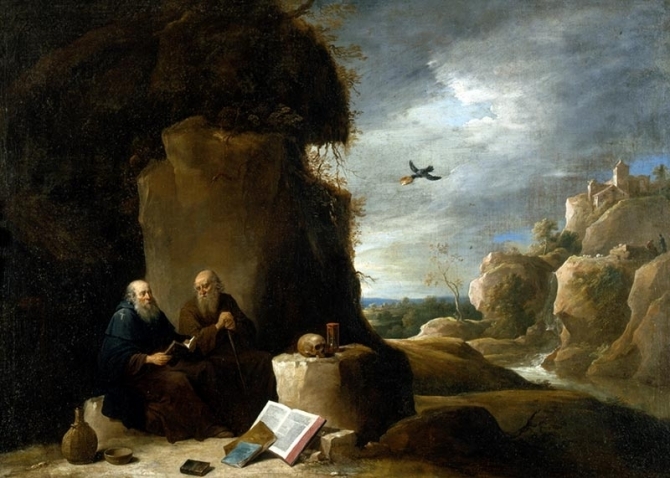
THE EXTERNAL GARDEN AND THE OUTER CHURCH
In January 1891, Bérenger Saunière obtained municipal permission from the management of Rennes le Château and began work on the construction of the garden in front of his church, always at his own expense.
On June 21st of the same year, the garden is inaugurated and a statue of the Virgin Mary is placed on the Carolingian pillar of the old altar installed upside down, an error that exactly as the previous analogs appears perfectly voluntary, as if to underline a particular coherence.
To better outline the purpose of the outdoor garden, we have the position of the Calvary, which in line of air and position serves as exactly as "double mirror" of the altar placed inside the church.
The positioning and the inversion of the Carolingian pillar is a fundamental element, especially related to the numerous other inversions observed in and around the church.
An example that shows the will to underline this desired symmetry is that of the priest when, after having found the "Dalle des Chevaliers" with his face towards the ground, in front of the altar, he removes it from the parish, to position it at the outside, with the face this time placed upwards, exactly at the foot of the Calvary, which represents the "double mirror" of the main altar inside the church.
Just draw a plan of the church and the garden to realize that the shape of the church plan is not actually that the "double mirror" of the garden and vice versa.
In this way the central alley of the church becomes the path that leads to Calvary, the confessional takes the place of the inverted pillar, the main altar takes the place of Calvary.
Thus we discover that the exact perimeter of the church of Saint Mary Magdalene is mirrored in its garden.
